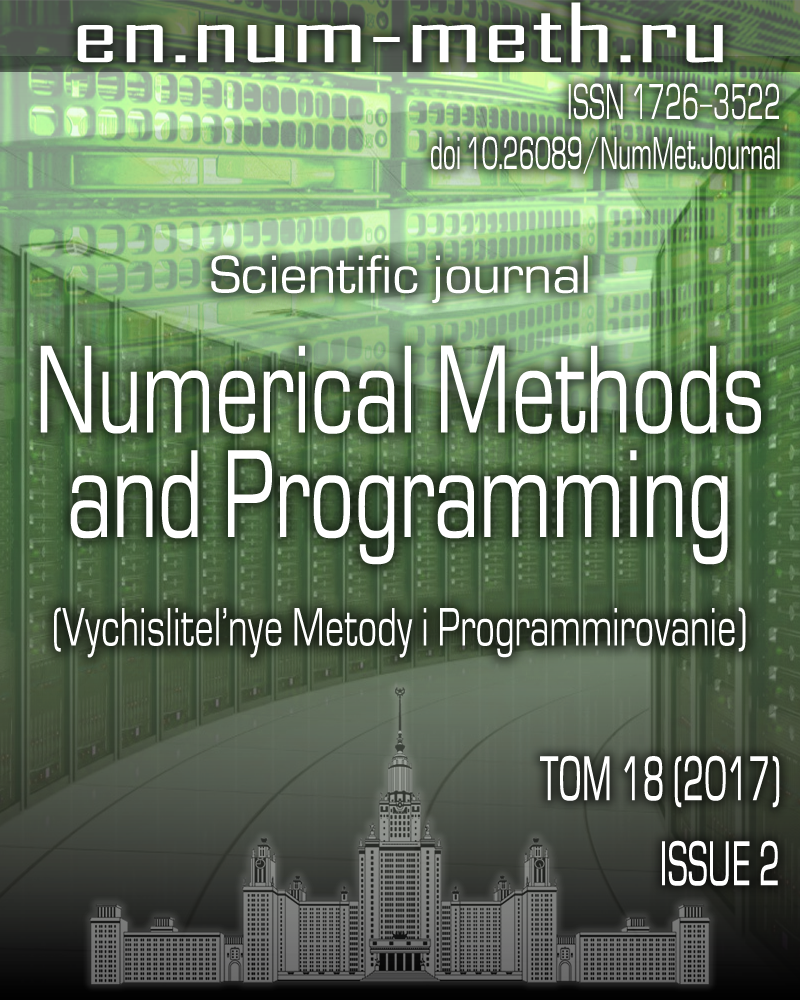DOI: https://doi.org/10.26089/NumMet.v18r212
A simplified numerical method to determine the shear stress relaxation time parameters by the example of polymers
Keywords:
Abstract
A numerical method to determine the parameters of the shear stress relaxation time is discussed. This function is one of the constitutive equations of a Maxwellian viscoelastic model. The method is based on a simplification of the system of equations describing the deformation of a thin rod when this system is considered at the yield stress point. The method allows one to find the relaxation time parameters responsible for the yield stress description in a wide range of temperatures and strain rates. The numerical results obtained by the method are compared with experimental data for polymethylmethacrylate, polytetrafluoroethylene, and epoxy resin.
Published
Issue
Section
References
- S. K. Godunov and E. I. Romenskii, Elements of Continuum Mechanics and Conservation Laws (Nauchnaya Kniga, Novosibirsk, 1998; Kluwer, New York, 2003).
- L. A. Merzhievskii and A. D. Resnyanskii, “Shock-Wave Processes in Metals,” Fiz. Goreniya Vzryva 20 (5), 114-122 (1984) [Combust., Expl., Shock Waves 20 (5), 580-587 (1984)].
- L. A. Merzhievskii, “Simulation of the Dynamic Compression of Polycrystalline Al2O3,” Fiz. Goreniya Vzryva 34 (6), 85-94 (1998) [Combust., Expl., Shock Waves 34 (6), 679-687 (1998)].
- L. A. Merzhievskii and M. S. Voronin, “Modeling of Shock-Wave Deformation of Polymethyl Metacrylate,” Fiz. Goreniya Vzryva 48 (2), 113-123 (2012) [Combust., Expl., Shock Waves 48 (2), 226-235 (2012)].
- S. K. Godunov, V. V. Denisenko, N. S. Kozin, and N. K. Kuz’mina, “Use of Relaxation Viscoelastic Model in Calculating Uniaxial Homogeneous Strains and Refining the Interpolation Equations for Maxwellian Viscosity,” Zh. Prikl. Mekh. Tekh. Fiz. 16 (5), 162-167 (1975) [J. Appl. Mech. Tech. Phys. 16 (5), 811-814 (1975)].
- L. A. Merzhievskii and S. A. Shamonin, “Construction of the Time Dependence of the Relaxation of Tangential Stresses on the State Parameters of a Medium,” Zh. Prikl. Mekh. Tekh. Fiz. 21 (5), 170-179 (1980) [J. Appl. Mech. Tech. Phys. 21 (5), 716-724 (1980)].
- L. A. Merzhievskii and A. V. Paletsky, “Calculations for Diagrams of Dynamic Deformation of Metals and Alloys,” Fiz. Mezomekh. 4 (3), 85-96 (2001).
- V. M. Kosenkov, “Determination of Relaxation and Dislocation Characteristics of Metals on the Basis of Shock Compression Diagrams,” Zh. Prikl. Mekh. Tekh. Fiz. 55 (4), 33-42 (2014) [J. Appl. Mech. Tech. Phys. 55 (4), 578-585 (2014)].
- S. A. Bordzilovskii, S. M. Karakhanov, L. A. Merzhievskii, and M. S. Voronin, “Temperature Measurements for Shocked Polymethylmethacrylate, Epoxy Resin, and Polytetrafluoroethylene and Their Equations of State,” J. Appl. Phys. 120 (2016).
doi 10.1063/1.4964303 - G. M. Bartenev and A. G. Barteneva, Structure and Relaxation Properties of Polymers (Khimiya, Moscow, 1992) [in Russian].
- C. Bauwens-Crowet, “The Compression Yield Behaviour of Polymethyl Methacrylate over a Wide Range of Temperatures and Strain-Rates,” J. Mater. Sci. 8 (7), 968-979 (1973).
- J. Richeton, S. Ahzi, L. Daridon, and Y. Rémond, “A Formulation of the Cooperative Model for the Yield Stress of Amorphous Polymers,” Polymer 46 (16), 6035-6043 (2005).
- J. L. Jordan, J. R. Foley, and C. R. Siviour, “Mechanical Properties of Epon 826/DEA Epoxy,” Mech. Time-Depend. Mater. 12 (3), 249-272 (2008).
- W. R. Blumenthal, C. M. Cady, M. F. Lopez, et al., “Influence of Temperature and Strain Rate on the Compressive Behavior of PMMA and Polycarbonate Polymers,” AIP Conf. Proc. 620 (1), 665-668 (2002).
- J. Richeton, S. Ahzi, K. S. Vecchio, et al., “Modeling and Validation of the Large Deformation Inelastic Response of Amorphous Polymers over a Wide Range of Temperatures and Strain Rates,” Int. J. Solids Struct. 44 (24), 7938-7954 (2007).
- A. D. Mulliken and M. C. Boyce, “Mechanics of the Rate-Dependent Elastic-Plastic Deformation of Glassy Polymers from Low to High Strain Rates,” Int. J. Solids Struct. 43 (5), 1331-1356 (2006).
- V. A. Bershtein, V. M. Yegorov, and Yu. A. Yemel’yanov, “Relations Between the Main Relaxation Transitions in Polymers and the Length of Segments and the Character and Degree of Cooperation in Molecular Motion in the Vicinity of T_g,” Vysokomol. Soyed. 27 (11), 2451-2457 (1985) [Polymer Sci. U.S.S.R. 27 (11), 2757-2764 (1985)].
- V. A. Bershtein and V. M. Yegorov, “General Mechanism of the β Transition in Polymers,” Vysokomol. Soyed. 27 (11), 2440-2451 (1985) [Polymer Sci. U.S.S.R. 27 (11), 2743-2757 (1985)].
- P. J. Rae and D. M. Dattelbaum, “The Properties of Poly(tetrafluoroethylene) (PTFE) in Compression,” Polymer 45 (22), 7615-7625 (2004).
- J. L. Jordan, C. R. Siviour, J. R. Foley, and E. N. Brown, “Compressive Properties of Extruded Polytetrafluoroethylene,” Polymer 48 (14), 4184-4195 (2007).
- S. F. Lau and B. Wunderlich, “Calculation of the Heat Capacity of Linear Macromolecules from Theta-Temperatures and Group Vibrations,” J. Therm. Anal. 28 (1), 59-85 (1983).
- B. E. Clements, “Low-Pressure Equation of State of Polymers,” AIP Conf. Proc. 845 (1), 57-60 (2006).
- E. N. Brown, D. M. Dattelbaum, D. W. Brown, et al., “A New Strain Path to Inducing Phase Transitions in Semi-Crystalline Polymers,” Polymer 48 (9), 2531-2536 (2007).
- G. V. Kozlov and D. S. Sanditov, Anharmonic Effects and Physicomechanical Properties of Polymers (Nauka, Novosibirsk, 1994) [in Russian].
- W. Chen and B. Zhou, “Constitutive Behavior of Epon 828/T-403 at Various Strain Rates,” Mech. Time-Depend. Mater. 2 (2), 103-111 (1998).
License
Copyright (c) 2017 Вычислительные методы и программирование

This work is licensed under a Creative Commons Attribution 4.0 International License.

